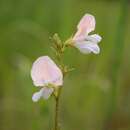Comprehensive Description
provided by North American Flora
Cracca spicata (Walt.) Kuntze, Rev. Gen. 175. 1891
Cracca virginiana L. Sp. PI. 752, in part. 1753.
Galega virginiana L. Sp. PI. ed. 2. 1062, in part. 1763.
Galega spicata Walt. PI. Car. 188. 1788.
Galega villosa Michx. PI. Bor. Am. 2: 67. 1803. Not G. villosa I,. 1759.
Tephrosia villosa (Michx.) Pers. Syn. PI. 2: 329. 1807. Nut T. villosa (L.) Pers. Syn. PI. 2: 329.
1807. Tephrosia paucijolia Nutt. Gen. 2: 119. 1818.
Galega JloriJa P. G. Dietr. Vollst. Lex. Gaertn. Nachtr. 3. 422, as tu synonym. 1817. Tephrosia hispida DC. Prodr. 2: 250. 1825.
Galena paucijolia Nutt.; M. A. Curt. Bost. Jour. Nat Hist. 1: 122. 1837. Tephrosia spicata T & G. Fl. N. Am. 1 : 296. 1838. Tephrosia mollissima Bertul. Mem. Accad. Bologna 2 : 274. 1850.
A perennial, with a strong and long woody root; stem decumbent or ascending, flexuose, somewhat angled, rusty hirsute-villous throughout, sometimes becoming glabrate below; leaves 5-15 cm. long; stipules 5-10 mm. long, often persistent, linear lanceolate; petiole 3-20 mm. long; rachis villous-hirsute; leaflets 5-15, broadly oblong to oval or obovate, obtuse, mucronate, often reflexed, 1.5-3.5 cm. long, 7-15 mm. wide, sparingly silky or glabrate above, densely villous or pilose beneath; racemes elongate, lax, opposite the leaves, including the peduncle 1-3 dm. long; bracts 5-10 mm. long, subulate, persistent; flowers 1-3 at each node, mostly near the end of the peduncle; calyx silky-hirsute, the tube 2 mm. long, the lobes subulate, 3-4 mm. long; corolla white or purple, 12-15 mm, long; banner strigose without, suborbicular, short-clawed; wings oblanceolate, longer than the keel, pod 3—5 cm. long, 5-6 mm. wide, acute, straight, S-12-seeded; seeds brown.
Type locality: Carolina.
Distribution: Sandy pine lands from Delaware and Virginia to Tennessee, Mississippi, and Florida.
- bibliographic citation
- Per Axel Rydberg. 1919. (ROSALES); FABACEAE; PSORALEAE. North American flora. vol 24(1). New York Botanical Garden, New York, NY
Comprehensive Description
provided by North American Flora
Cracca flexuosa (Chapm) A. Heller, Cat N. Am PI ed. 2. 7 1900.
Tephrosia hispidula 7 T. & G. Fl. N. Am. 1 : 297. 1838.
Tephrosia flexuvsa Chapm.; T. & G. Fl. N. Am. 1: 297, as synonym. 1838.
Tephrosia villosa flexuosa B. I,. Robinson, Bot. Gaz. 28: 200. 1899.
A perennial, from a woody root; stem slender, 2-6 dm. high, flexuose, sparingly hirsute; leaves 6-12 dm. long; stipules subulate, 8-10 mm. long, hirsute, persistent; petiole 1-3 cm. long; rachis hirsute; leaflets 3-15, linear or lance-linear, long-acute, glabrous or puberulent above, hirsute and with stiong reddish veins beneath, the lateral ones spreading or reflexed, 1-3 cm. long, 2-4 mm. wide, the terminal one larger, 1.5-4.5 cm. long; racemes lax, fewflowered, 8-18 cm. long; flowers 1 or 2 at each node; bracts subulate; calyx hirsute, the tube 2.5 mm. long, the lobes subulate, 3.5-4 mm. long; corolla 12 mm. long; banner suborbicular, short-clawed, strigose without; wings obliquely oblanceolate, round at the apex, with an acute basal auricle.
Type locality: Florida.
Distribution: Florida and Alabama.
- bibliographic citation
- Per Axel Rydberg. 1919. (ROSALES); FABACEAE; PSORALEAE. North American flora. vol 24(1). New York Botanical Garden, New York, NY
Physical Description
provided by USDA PLANTS text
Perennial, Herbs, Stems woody below, or from woody crown or caudex, Taproot present, Nodules present, Stems or branches arching, spreading or decumbent, Stems less than 1 m tall, Stems solid, Stems or young twigs sparsely to densely hairy, Stem hairs hispid to villous, Leaves alternate, Leaves petiolate, Stipules inconspicuous, absent, or caducous, Stipules setiform, subulate or acicular, Stipules persistent, Stipules free, Leaves compound, Leaves odd pinnate, Leaf or leafl et margins entire, Leaflets opposite, Leaflets 10-many, Leaves hairy on one or both surfaces, Inflorescences racemes, Inflorescence terminal, Inflorescence leaf-opposed, Bracts conspicuously present, Flowers zygomorphic, Calyx 5-lobed, Calyx hairy, Petals separate, Corolla papilionaceous, Petals clawed, Petals ochroleucous, cream colored, Petals greenish yellow, Petals pinkish to rose, Petals reddish brown, maroon, Petals bicolored or with red, purple or yellow streaks or spots, Banner petal ovoid or obovate, Banner petal suborbicular, broadly rounded, Wing petals narrow, oblanceolate to oblong, Wing petals auriculate, Wing tips obtuse or rounded, Keel petals auriculate, spurred, or gibbous, Keel tips obtuse or rounded, not beaked, Stamens 9-10, Stamens diadelphous, 9 united, 1 free, Filaments glabrous, Style terete, Style sharply bent, Style hairy, Style hairy on one side only, Fruit a legume, Fruit unilocular, Fruit freely dehiscent, Fruit elongate, straight, Fruit exserte d from calyx, Valves twisting or coiling after dehiscence, Fruit beaked, Fruit hairy, Fruit 3-10 seeded, Seeds ovoid to rounded in outline, Seed surface smooth, Seeds olive, brown, or black, Seed surface mottled or patchy.

